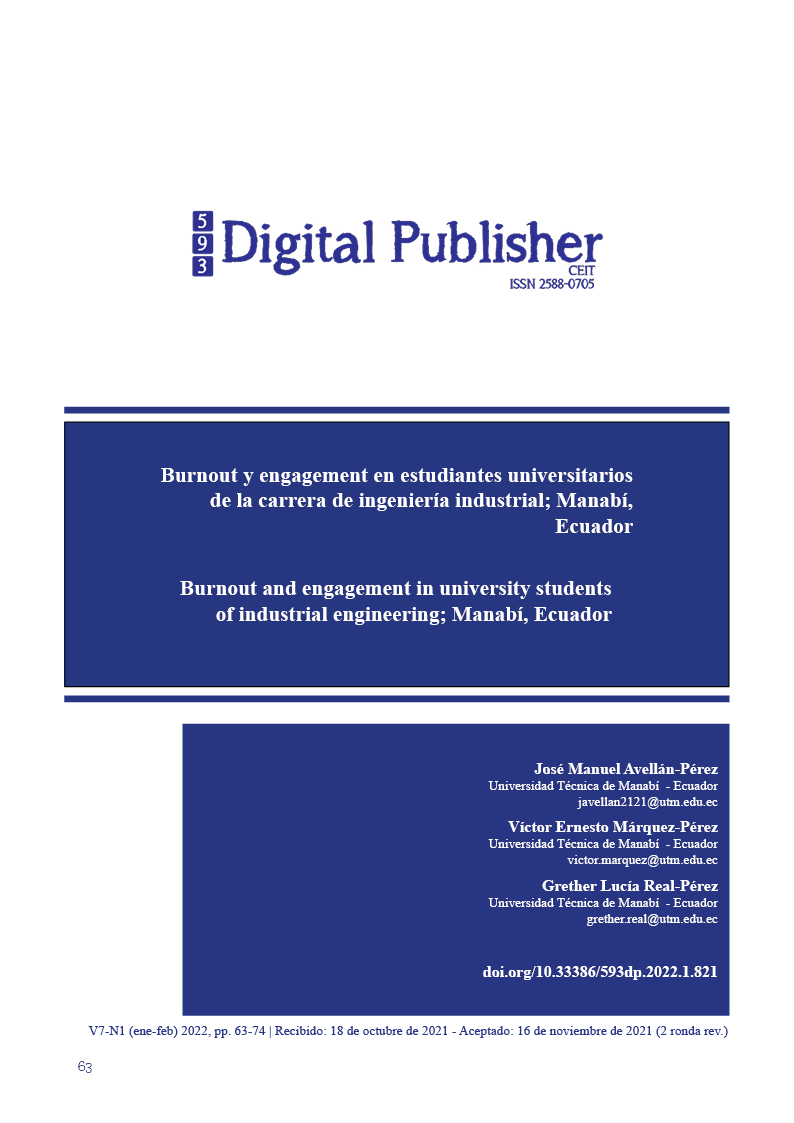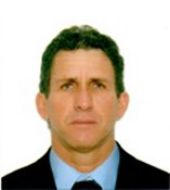Burnout and engagement in university students of industrial engineering, Manabí, Ecuador
Main Article Content
Abstract
University students, with the arrival of the Covid 19 pandemic, have had to assume different study modalities, which without having the appropriate conditions become factors that generate stress. The objective of this work was to measure burnout (syndrome of being burned out) and its engagement (commitment or way of facing burnout or stressful situations) in students of a university in Ecuador. The sample was 412 students. To measure burnout, the Maslach Burnout Inventory (MBI) questionnaire was applied, responding to a Likert scale from 0 never implied to 6 always, evaluating its three dimensions (Academic Self-efficacy, Emotional Exhaustion and Cynicism) as low, medium, and high. To assess engagement, the Academic Engagement Questionnaire (UWES-S) was used, with three dimensions (vigor, dedication, and absorption) using the same rating scale as burnout. The study begins with the characterization of the students, considering, on the one hand, the sociodemographic variables: gender, age, work, children, area in which they live and marital status and, on the other, the assessment of the study conditions. The chi square test was used to search for relationships between the sociodemographic and study variables, concluding that gender affects absorption engagement (8.238 chi square, p 0.016) and predominant engagement (9.724 chi square, p 0.008); however, age had a direct impact on academic self-efficacy (chi square 9,633, p 0.047). The analyzes of
the rest of the sociodemographic variables and study conditions did not show statistically significant differences. The study allows us to conclude that women present higher levels of absorption and predominant engagement in relation to men, and that younger students between 18 and 23 years of age are the ones with the lowest academic self-efficacy.
Downloads
Article Details

This work is licensed under a Creative Commons Attribution-NonCommercial-ShareAlike 4.0 International License.
1. Derechos de autor
Las obras que se publican en 593 Digital Publisher CEIT están sujetas a los siguientes términos:
1.1. 593 Digital Publisher CEIT, conserva los derechos patrimoniales (copyright) de las obras publicadas, favorece y permite la reutilización de las mismas bajo la licencia Licencia Creative Commons 4.0 de Reconocimiento-NoComercial-CompartirIgual 4.0, por lo cual se pueden copiar, usar, difundir, transmitir y exponer públicamente, siempre que:
1.1.a. Se cite la autoría y fuente original de su publicación (revista, editorial, URL).
1.1.b. No se usen para fines comerciales u onerosos.
1.1.c. Se mencione la existencia y especificaciones de esta licencia de uso.
References
Castro Toro, E. (2018). Rendimiento académico y estrés en estudiantes de enfermería, Universidad Nacional Toribio Rodríguez de Mendoza, Chachapoyas-2017. Tesis para optar el Título Profesional de Licenciada en Enfermería, UNIVERSIDAD NACIONAL TORIBIO RODRÍGUEZ DE MENDOZA DE AMAZONAS, FACULTAD DE CIENCIAS DE LA SALUD. ESCUELA PROFESIONAL DE ENFERMERÍA, Perú. Obtenido de Recuperado de: http://repositorio.untrm.edu.pe/handle/UNTRM/1397
Corral-Espinel, H., & Hidalgo-Avila, A. (2020). Influencia del estrés laboral en docentes de colegios particulares católicos. 593 Digital Publisher, Volumen 5(Nùmero 5), 180-190. doi:doi.org/10.33386/593dp.2020.5-1.333
Corrêa de Mattos, C., Braga Abud, G., Da Silva Barbosa, K., Rodrigues Moreira, M., & Andrade Mancebo, C. (2020). A SÍNDROME DE BURNOUT ENTRE ESTUDANTES UNIVERSITÁRIOS: UMA INVESTIGAÇÃO MULTIVARIADA NO BACHARELADO EM ADMINISTRAÇÃO DE UMA INSTITUIÇÃO FEDERAL DE ENSINO SUPERIOR NA REGIÃO NORTE DO BRASIL. Revista GUAL, Florianópolis, Volumen 13(3), 141-163. Obtenido de Recuperado de: www.gual.ufsc.br
García Guevara, R., Millán Ochoa, J., Padilla Hermosillo, A., López Silva, D., & Hernández Sanz, C. (2021). Perfil de estrés y síndrome de burnout en estudiantes de la Facultad de Odontología de la Universidad Autónoma de Sinaloa. Ciencia en la frontera: revista de ciencia y tecnología de la UACJ., Suplemento I. Obtenido de Recuperado de: erevistas.uacj.mx/ojs/index.php/cienciafrontera/article/download/3538/3256
IESALC. (2020). Covid 19 y la Educación Superior: de los efectos inmediatos al día después. Análisis de impactos, políticas y recomendaciones. Pag. 9. Obtenido de Recuperado de: https://www.google.com/search?client=firefox-b-d&q=COVID-19+y+educaci%C3%B3n+superior%3A+De+los+efectos+inmediatos+al+d%C3%ADa+despu%C3%A9s
Liébana, C., Fernández, M., Vázquez, A., López, A., & Rodríguez, M. (2018). Burnout y engagement en estudiantes universitarios de enfermería. Enfermería Global, Volumen 17(Número 50), Pp. 132-141. doi:https://dx.doi.org/10.6018/eglobal.17.2.268831
Liébana-Presa, C., Fernández-Martínez, M., Vázquez-Casares, A., López-Alonso, A., & Rodríguez-Borrego, M. (2018). Burnout and engagement among university nursing students. Enfermería Global. Obtenido de Recuperado de: http://dx.doi.org/10.6018/eglobal.17.2.268831
Martos, Á., Pérez-Fuente, M., Molero, M., Gázquez, J., Simón, M., & Barragán, A. (2018). Burnout y engagement en estudiantes de Ciencias de la Salud. European Journal of Investigation in Health, Psychology and Education, Volumen 8. No. 1, Pp. 23-36. doi:Doi: doi: 10.30552/ejihpe.v8i1.223
Maslach, C., & Jackson, S. (1981). The measurement of experienced burnout. Journal of occupational behaviour, Volumen 2(Número 2), PP. 99-113. doi: https://doi.org/10.1002/job.4030020205
Merchán-Galvis, Á., Albino Matiz, A., Bolaños-López, J., Millán, N., & Arias-Pinzón, A. (2018). Burnout syndrome and associated factors in medical students. Higher Medical Education, Volumen 32 (Nùmero 3), 172-180. Obtenido de Recuperado de: http://scielo.sld.cu/scielo.php?script=sci_arttext&pid=S0864-21412018000300014
Moreta-Herrera, R., Lara-Salazar, M., Camacho-Bonilla, P., & Sánchez-Guevara, S. (2019). Análisis factorial, fiabilidad y validez de la escala de autoeficacia general (EAG) en estudiantes ecuatorianos. Psychology, Society, & Education, Volumen 11(2), 193-204. Obtenido de Doi 10.25115/psye.v10i1.2024
Nogareda, S. (1999). NTP 355: Fisiología del estrés. Norma Técnica de Prevención, Pp. 1-6.
Pereyra Girardi, C., Páez Vargas, N., Ronchieri Pardo, C., & Agustina Trueba, D. (2019). Validación de la Escala de Autoeficacia para el Afrontamiento del Estrés en estudiantes universitarios. Revista de Psicología (PUCP), 37(2), 473–493. doi:Recuperado de: https://doi.org/10.18800/psico.201902.005
Rojas-Melgarejo, J., Mereles-Oviedo, F., Barrios, I., & Torales, J. (2017). SÍNDROME DE BURNOUT EN ESTUDIANTES DE MEDICINA DE SANTA ROSA DEL AGUARAY. Medicina Clínica y Social, Volumen 1(1), 26-30. doi:https://doi.org/10.52379/mcs.v1i1.8
Vallejo-Martín, M., Aja Valle, J., & Plaza Angulo, J. (2018). Estrés percibido en estudiantes universitarios: influencia del burnout y del engagement académico. International Journal of Educational Research and Innovation (IJERI), Volumen 9, Pp. 220-236. Obtenido de Recuperado de: https://www.upo.es/revistas/index.php/IJERI/article/view/2558
Vallejo-Martín, M., Aja Valle, J., & Plaza Angulo, J. (2018). Estrés percibido en estudiantes universitarios: influencia del burnout y del engagement académico. Revista internacional de investigación e innovación educativa, 220-236. Obtenido de Recuperado de: https://www.upo.es/revistas/index.php/IJERI/
Velasco, R., Cunalema, J., Franco, J., & Vargas, G. (enero - marzo de 2021). Estrés percibido asociado a la pandemia por COVID-19 en la ciudad de Guayaquil, Ecuador q. Ministerio del Poder Popular para la Salud. Boletín de Malariología y Salud Ambiental., Volumen 61. Número 1, Pp. 38. Obtenido de Recuperado de: https://doi.org/10.52808/bmsa.7e5.611.006




